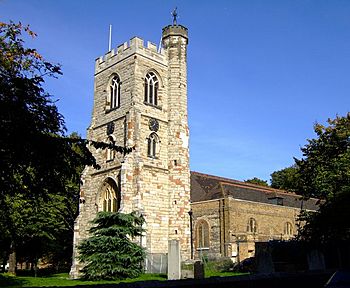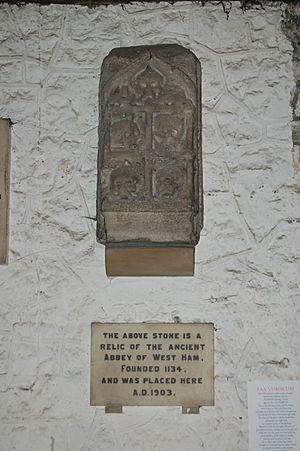All Saints Church, West Ham facts for kids
Quick facts for kids All Saints Church, West Ham |
|
|---|---|
 |
|
| 51°32′11″N 0°0′31″E / 51.53639°N 0.00861°E | |
| Location | West Ham, Newham, London |
| Country | England |
| Denomination | Church of England |
| History | |
| Founded | 12th century |
| Administration | |
| Archdeaconry | West Ham |
| Episcopal area | Barking |
| Archdiocese | Canterbury |
| Diocese | Chelmsford |
All Saints Church is a very old church located in West Ham, a part of east London. It has been a special Grade I listed building since 1984. This means it's considered a very important historical building.
Contents
A Look Back in Time
How It All Began: Medieval Times

In the Middle Ages, All Saints Church covered most of West Ham. There was a small exception: 24 acres around Stratford Langthorne Abbey. This area had its own church, St Mary and All Saints. But when the abbey closed down, its church was destroyed. Then, its parish joined All Saints.
People believe there has been a church on this spot since at least the late 1100s. Some old windows in the church show this. A document from 1181-82 by Henry II of England confirmed that the church belonged to the abbey. Around the same time, a bishop named Gilbert Foliot assigned a vicar (a priest) to the church. The church still has a stone carving and possibly parts of a font from the old abbey.
The main part of the church, called the nave, was largely rebuilt in the mid-1200s. Around 1400, the church was made longer. A new tower was also added at the west end. The abbey owned the church until the king took it over after the monasteries were closed. In the mid-1400s, two chapels were added, one on the north side and one on the south. Many windows in the north aisle were also replaced around this time. Wall paintings from the 1400s were found in the nave during later repairs. Around 1547, the churchwardens sold some church items to pay for rebuilding the north chapel with bricks.
Growing Pains: The 1700s and 1800s
One of the three fonts (a basin for baptisms) in the church was added in 1707. In 1710, a gallery was built at the west end, and an organ was put there 21 years later. More galleries were added in 1727 and 1735 to make space for more people. The west gallery was rebuilt in 1763. The pulpit, where the priest gives sermons, was changed in 1788-90. A long porch was also added by 1799, but it was removed later. From 1800 to 1803, parts of the church were refaced with yellow bricks.
The number of people in the parish grew a lot. So, all three galleries were made bigger between 1821 and 1824. Even with these changes, only a small part of the local population could fit in the church. Because of this, new smaller churches, called "chapels of ease," were built. These included St Mary's Church, Plaistow in 1830 and St John's Church, Stratford in 1834. These chapels later became separate churches with their own parishes. Other new churches, like Christ Church, Stratford and St Mark's Church, Forest Gate, also took parts of All Saints' original parish.
Architects George Dyson and George Gilbert Scott rebuilt All Saints Church between 1847 and 1849. They replaced the old box pews with new ones, allowing more people to sit. Scott returned in 1865–1869. He removed the west gallery and added new windows. Another larger font was added in 1869. More changes happened in 1879-1880 and 1892, when the north and south galleries were removed. All Saints also helped start other mission churches, like St Thomas's Church, West Ham and St Matthew's Church, West Ham.
All Saints Church Today
All Saints Church has a few interesting features. One is the baptismal font from 1707. It has the names of three churchwardens, not the usual two. This is because the old parish was divided into three areas, and this tradition continues.
Another cool thing is the clock in the tower. It was made in 1857 based on a design by Lord Grimthorpe. This clock was actually the first version of the famous Big Ben clock in London!

